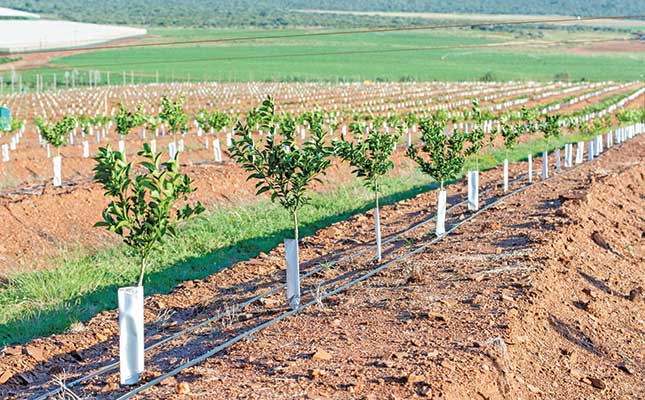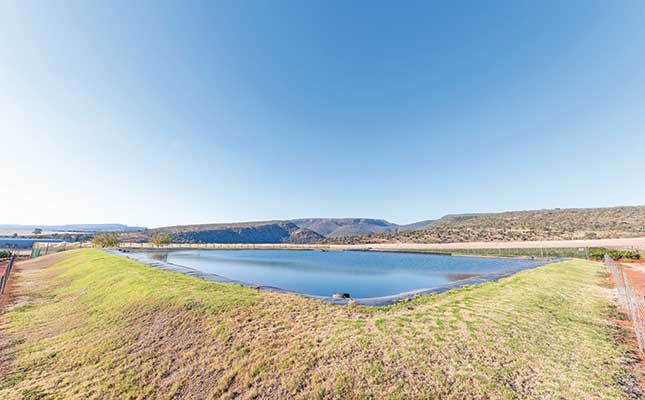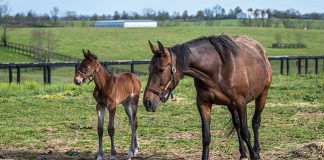
Photo: Mahela Group
The Mahela Group in the Letsitele Valley ascribes its success as a citrus producer to the sound investments it makes in the latest agricultural technologies and sustainable farming practices. In addition, the company has begun improving its cash flow and spreading risk by investing in subtropical crops, game and livestock farming.
As director of the citrus division, Eddie Vorster is responsible for all aspects of production. According to him, the region’s warm days and cool nights are conducive to producing most types of citrus with well-balanced levels of sugar and acidity, as well as good fibre and moisture content.
Mahela produces a wide range of citrus, namely Shaddock (pomelos); Star Ruby grapefruit; Cara Cara navel oranges; Delta, Midknight, Turkey and other late Valencia oranges; Tango, Nules Clementine, Gold Nugget and Samba soft citrus; and Eureka and Genoa lemons. The fruit is produced mainly for the export market.
All the group’s farms, apart from one, are located in Limpopo. The exception is a farm near George in the Western Cape. Each farm is under the watchful eye of a manager or, in the case of larger farms, two managers, each with a team of dedicated personnel.
According to Vorster, market changes present some of the biggest challenges they have to address every year. “These changes aren’t only seasonal; they can occur at any time of the year.
The market will dictate a certain fruit size and we have to manage production to achieve those parameters. But depending on demand, these can easily change. Market information is crucial for us on the production side; the sooner we know what the market’s needs are, the easier it is to manage production.”
Citrus exporters like Mahela also have the burden of meeting phytosanitary regulations. In addition, logistical issues this year have proved a major challenge for most South African citrus farmers, especially those in the northern part of the country, and Mahela is no exception.
The Nursery
Mahela’s citrus production starts at the nursery on The Junction farm near Letsitele.
“We use the latest technology to produce high-quality, certified-disease-free citrus trees for all our citrus farms,” says Vorster.
“Good rootstocks have a positive effect on yield, fruit size and quality. Rootstocks vary in their adaptability to different soil types, as well as their tolerance of adverse soil conditions, pests and diseases. At the nursery, we make sure our trees have good root development, and that they’ll thrive under our diverse conditions and be able to produce fruit for the next 30 years.”
Mahela’s nursery strives to produce quality trees by using certified seed and plant material. It has Citrus Research International accreditation, is a member of the South African Citrus Nurserymen’s Association, is registered with the Department of Agriculture, Land Reform and Rural Development in terms of the Plant Improvement Act, and is accredited by the Southern African Citrus Improvement Scheme.
Soil preparation
Citrus trees bloom for four to six weeks from September to October, and the first fruit set is in mid-October, depending on the cultivar. The second bloom usually occurs in late November and continues into early December. Depending on the area, the type of citrus and the cultivar, fruit picking starts in March and lasts until the end of September.
“We start our picking season with the lemons, followed by the Shaddock and grapefruit from early April until mid-June. The picking of navel oranges kicks off in the last week of May, soft citrus from the end of July until late August, and our other orange varieties from then until the end of September.”
Citrus are suited to a wide range of well-drained soil types.
“We focus on proper soil and ridge preparation with a view to long-term production,” says Vorster. Ridging is important, as it allows for more optimal soil, water and nutrient management, and creates a healthy and well-aerated root zone.
“Ridging has had a major impact on our cultivation practices and our integrated pest management focus. We also adapt our irrigation practices to suit the soil type and climate. On the Ohrigstad and George farms, we use low-flow drip irrigation in our orchards, while on our Letsitele, Hoedspruit and Weipe farms, we use micro-irrigation.
“Once the trees are in the ground, they may be there for quite some time, so proper planning with careful consideration for all production and environmental aspects is needed. Most fruit trees require between six and eight hours of sunlight for good growth and fruit ripening, so the amount of sunlight the area receives during the growing season, as well as the soil type, will have an impact on them.”
Soil health and nutrients
Being able to deliver fruit of the highest quality to demanding global markets starts with perfecting the basics of first-class production practices. Nutrition is a key element and, according to Vorster, all mineral nutrients must be available to the trees in sufficient quantities in order to achieve optimal yield and fruit development. There should also be a balanced supply of macro- and micronutrients.
Soil and leaf analyses are carried out annually to determine the correct applications of these nutrients. Macronutrients include nitrogen, phosphorus, potassium, calcium, magnesium and sulphur.
The correct amount of nitrogen is important, as it affects growth and, together with potassium and calcium, is needed for leaf, flower and fruit production.
Phosphorus helps the trees store and use energy and take in other nutrients, and aids cell division and growth. Magnesium is crucial for photosynthesis and assists with phosphorus uptake, while sulphur improves root growth.
The micronutrients or trace elements include iron, zinc, manganese and molybdenum.
Mahela also uses organic fertiliser, compost and manure to address soil imbalances and optimise yields.
“Energy analysis is a routine task in our farming operation, and we base our fertigation programme on these results,” says Vorster.
Water management
An unreliable supply of good-quality water is one of the main challenges facing fruit farmers in the Letsitele Valley, according to Vorster.
“Our water sources are important assets, but they need meticulous management. We try to approach our irrigation in a holistic manner to ensure sustainable water use and fruit production. Through implementing precision irrigation systems, we’ve managed to reduce some of the risks associated with citrus production by delivering precise quantities of water and nutrients to the roots of each plant,” he explains.
A few years ago, Mahela invested in additional boreholes to ensure a water supply in drier seasons. All irrigation water is pumped into sealed dams to prevent it from seeping into the soil.
“Precision irrigation enables us to save water and fertiliser. It also aids in producing excellent-quality fruit, as we can provide consistent and uniform water during critical growth periods, minimising water stress throughout the fruit development phase.
“We regard precision drip irrigation as a more sustainable approach, as it allows water to reach the plant at the right time and place and in small, measured doses,” says Vorster.
The Ohrigstad farm is suited to drip irrigation, as the netting in the orchard reduces the effect of the wind and helps lower the soil temperature. On the farm near George, the drip irrigation ensures that the water reaches the critical zone around the plants’ roots.
“If we’d installed micro-irrigation systems, the wind would’ve blown the water spray away from the ridges and root zones. Drip irrigation mitigates the effect of the wind on irrigation,” he explains.
By contrast, micro-irrigation is more effective on the Letsitele, Hoedspruit and Weipe farms where the wind doesn’t pose the same challenges. Soil temperatures here can easily exceed 30°C in summer, and micro-irrigation plays an important role in cooling down the soil in the root zone.
Citrus trees have shallow root systems concentrated under their canopies, and the best root development takes place when soil temperatures range from 15°C to 30°C.
In the orchards with drip irrigation systems, two irrigation lines are installed per row, with drippers spaced 1m apart and delivering water at a rate of 1,6ℓ/h. This equates to about 4,9m³/h/ha. In the orchards with micro-irrigation, only one line per ridge is installed, and each tree receives approximately 30ℓ/h, or roughly 14m³/h/ha.
“We found these two systems to be the most effective irrigation methods for our farms and circumstances, and are very pleased with the results we’re achieving,” says Vorster.
The irrigation schedule is based on hourly readings from the on-farm IrriCheck continuous-logging soil moisture probes. The physiological stage of the tree together with the transpiration that occurs on a specific day are also taken into account. Flow meters alert the farm managers to any irrigation problems.
“Thanks to the probes, we’re using 15% to 20% less water. In some areas, farmers used to irrigate with about 68ℓ/h for eight hours a day. Today, we use nozzles with a 30ℓ/h capacity, and irrigate an average of only three hours a day.”
Mahela has a farm maintenance team that ensures all pumps and irrigation systems are working optimally. Staff are encouraged to report faulty equipment immediately so that it can be repaired in good time.

Tree management
Mahela’s orchards are generally replaced after 25 to 30 years, but the ultimate decision of when to do so is based on the productivity of the trees and the orchard. The total yield of the orchard is calculated, as are the performances of individual trees. Vorster and his teams look at the average yield over the past couple of seasons, as well as the fruit size, weight, health and quality.
“When an orchard gets older, we prefer to replace the entire thing rather than individual trees, as it makes the overall management of the orchard easier,” he explains.
Mahela’s pruning programme allows for a winter and a summer pruning. The former is the most important, as it removes dead wood, allows for sun filtration through the canopies, and leads to better fruit quality. The summer pruning is focused more on maintenance and keeping the trees healthy.
Vorster explains that the trees are skirted only partially, as retaining most of the branches helps to create a microclimate below the tree that is conducive to optimal fruit production.
For this reason, only those branches that actually touch the soil surface are removed to prevent ants from climbing them. Although ants aid with pest control to some extent, they also facilitate the outbreak of other pests, such as those that produce honeydew. Ants can also affect the natural enemies of pests.
The pruned branches are cut into smaller pieces and either left between the trees as ground cover, or shredded and used as mulch around newly planted trees.
Integrated pest management
According to Vorster, some of the pests that have to be controlled in the orchards, for example citrus thrips (Scirtothrips aurantii), don’t affect the quality of the fruit, but blemish it and make it less marketable.
Pests such as fruit fly (Drosophila spp) also have to be managed as part of the phytosanitary requirements of importing countries. In addition, fruit fly and false codling moth (Thaumatotibia leucotreta) cause pre- and post-harvest waste problems.
Citrus black spot is a fungal disease that causes lesions on the rind of the fruit, and the EU has imposed phytosanitary regulations in this regard.
“It can be quite frustrating to lose a part of the harvest due to pests and disease, especially when we’re financially penalised for it,” admits Vorster. “Control of any pest, disease or fungal infection is thus extremely important and relies mostly on well-timed chemical applications at the start of the season and a follow-up with biological control practices.”
Mahela follows an integrated pest management (IPM) strategy on all of its farms, incorporating predatory insects to control pests and reduce the use of harmful chemicals.
“Our IPM programme is based on an ecosystem approach that focuses on sustainable, long-term solutions for managing pests. The aim is to reduce the use of non-selective chemicals to produce healthy crops with minimal impact on the environment and human health.”
Vorster’s advice to any farmer contemplating planting citrus is this: “Don’t make decisions based on emotion only, and make sure you stick to the basics. If you can master those, you can build a sound business on a solid platform, and incorporate technology to move forward.”
He adds that it’s good practice to learn from others in the area and, of course, to learn from one’s own mistakes. “Citrus farming is a long-term investment, so it’s important to gather as much information about it as possible before you start.”
It’s also critical to ensure that the citrus cultivars chosen are suited to the farming area.
His final bit of advice: “Stay in touch with what the market wants!”
Email the Mahela Group at [email protected].











